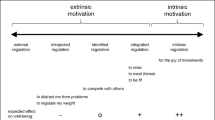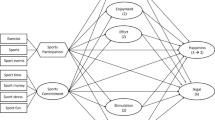Abstract
Interrelated functions of the three orientations to happiness were examined by a cross-sectional survey, in the context of a ski resort experience. Accordingly, a conceptual framework of pleasure, flow, and involvement influencing satisfaction was established. Utilizing structural equation modeling, the conceptual framework was tested by analyzing data collected from 279 participants who enjoyed skiing and/or snowboarding. Results from bootstrap test indicated that direct and total effects from flow had the highest predictive power on satisfaction. In contrast, pleasure showed higher explanatory power on subjective experiences of flow and meaning, and influenced satisfaction only by indirect effects through those elements. Together, these findings support the research model synthesizing the behavioral constructs of sport participation with subjective well-being perspectives. Moreover, the expanded model in a sporting context further evidences the functional roles of the orientations to happiness by results consistent with extant literature of positive psychology. Roles of embodiments of orientations to happiness in an action-based exercise and its implications are further discussed.

Similar content being viewed by others
References
Allender, S., Cowburn, G., & Foster, C. (2006). Understanding participation in sport and physical activity among children and adults: a review of qualitative studies. Health Education Research, 21(6), 826–835.
Anderson, J. C., & Gerbing, D. W. (1988). Structural equation modeling in practice: a review and recommended two-step approach. Psychological Bulletin, 103(3), 411–423.
Babbie, E. (2007). The practice of social research (11th ed.). Belmont, CA: Thomson Wadsworth.
Bagozzi, R. P., & Yi, Y. (1988). On the evaluation of structural equation models. Journal of the Academy of Marketing Science, 16(1), 74–94.
Baron, R. M., & Kenny, D. A. (1986). The moderator–mediator variable distinction in social psychological research: conceptual, strategic, and statistical considerations. Journal of Personality and Social Psychology, 51(6), 1173–1182.
Bentler, P. M. (1990). Comparative fit indexes in structural models. Psychological Bulletin, 107(2), 238–246.
Bollen, K. A., & Stine, R. A. (1992). Bootstrapping goodness-of-fit measures in structural equation models. Sociological Methods & Research, 21(2), 205–229.
Brown, S., & Vaughn, C. (2009). Play: How it shapes the brain, opens the imagination, and invigorates the soul. New York: Avery.
Compton, W. C., & Hoffman, E. (2013). Positive psychology: The science of happiness and flourishing. Belmont: Wadsworth.
Csikszentmihalyi, M. (1990). Flow: The psychology of optimal experience. New York: Harper & Row.
Csikszentmihalyi, M., & Csikszentmihalyi, I. (1975). Beyond boredom and anxiety: The experience of play in work and games. San Francisco: Jossey-Bass.
Dahlsgaard, K., Peterson, C., & Seligman, M. E. P. (2005). Shared virtue: the convergence of valued human strengths across culture and history. Review of General Psychology, 9(3), 203–213.
Decloe, M. D., Kaczynski, A. T., & Havitz, M. E. (2009). Social participation, flow and situational involvement in recreational physical activity. Journal of Leisure Research, 41(1), 73–90.
Diener, E. (2006). Guidelines for national indicators of subjective well-being and ill-being. Applied Research in Quality of Life, 1, 151–157.
Finney, S. J., & DiStefano, C. (2006). Non-normal and categorical data in structural equation modeling. In G. R. Hancock & R. O. Mueller (Eds.), Structural equation modeling: A second course (pp. 269–314). Greenwich: Information Age Publishing.
Fornell, C., & Larcker, D. F. (1981). Evaluating structural equation models with unobservable variables and measurement error. Journal of Marketing Research, 18(1), 39–50.
Fox, K. R., Boutcher, S. H., Faulkner, G. E., & Biddle, S. J. H. (2000). The case for exercise in the promotion of mental health and psychological well-being. In S. J. H. Biddle, K. R. Fox, & S. H. Boutcher (Eds.), Physical activity and psychological well-being (pp. 1–9). London: Routledge & Kegan Paul.
Fredrickson, B. L. (2001). The role of positive emotions in positive psychology: the broaden-and-build theory of positive emotions. American Psychologist, 56(3), 218–226.
Fredrickson, B. L. (2003). The value of positive emotions: the emerging science of positive psychology is coming to understand why it’s good to feel good. American Scientist, 91(4), 330–335.
Fredrickson, B. L., & Losada, M. F. (2005). Positive affect and the complex dynamics of human flourishing. American Psychologist, 60(7), 678–686.
Gagne, M. (2003). Autonomy support and need satisfaction in the motivation and well-being of gymnasts. Journal of Applied Sport Psychology, 15(4), 372–390.
Havitz, M. E., & Mannell, R. C. (2005). Enduring involvement, situational involvement, and flow in leisure and non-leisure activities. Journal of Leisure Research, 37(2), 152–177.
Hu, L., & Bentler, P. M. (1999). Cutoff criteria for fit indexes in covariance structure analysis: conventional criteria versus new alternatives. Structural Equation Modeling: A Multidisciplinary Journal, 6(1), 1–55.
Huang, H., & Humphreys, B. R. (2012). Sports participation and happiness: evidence from US microdata. Journal of Economic Psychology, 33(4), 776–793.
Jackson, S. A., & Hanin, Y. L. (2000). Joy, fun, and flow state in sport. In Y. L. Hanin (Ed.), Emotions in sport (pp. 135–155). Champaign: Human Kinetics.
Jackson, S. A., Kimiecik, J. C., Ford, S. K., & Marsh, H. W. (1998). Psychological correlates of flow in sport./correlations psychologiques de la serenite en sport. Journal of Sport & Exercise Psychology, 20(4), 358–378.
Jayawickreme, E., Forgeard, M. J. C., & Seligman, M. E. P. (2012). The engine of well-being. Review of General Psychology, 16(4), 327–342.
Kahneman, D., Diener, E., & Schwarz, N. (2003). Well-being: The foundations of hedonic psychology. New York: Russell Sage.
Keyes, C. L. M., Shmotkin, D., & Ryff, C. D. (2002). Optimizing well-being: the empirical encounter of two traditions. Journal of Personality and Social Psychology, 82, 1007–1022.
Kimiecik, J. C., & Harris, A. T. (1996). What is enjoyment? A conceptual/definitional analysis with implications for sport and exercise psychology. Journal of Sport & Exercise Psychology, 18(3), 247–263.
Kline, R. B. (2011). Principles and practice of structural equation modeling. New York: The Guilford Press.
Leckey, P. J., & Mannell, R. C. (2000). Confidence in personality impressions of others in leisure and work contexts: the role of implicit theories of leisure as expressive behavior. Leisure/Loisir, 24, 279–298.
Linley, P. A., & Joseph, S. (2004a). Applied positive psychology: A new perspective for professional practice. In P. A. Linley & S. Joseph (Eds.), Positive psychology in practice (pp. 3–12). Hoboken: Wiley.
Linley, P. A., & Joseph, S. (2004b). Toward a theoretical foundation for positive psychology in practice. In P. A. Linley & S. Joseph (Eds.), Positive psychology in practice (pp. 713–731). Hoboken: Wiley.
Madrigal, R. (2006). Measuring the multidimensional nature of sporting event performance consumption. Journal of Leisure Research, 38(3), 267–292.
Mannell, R. C., & Kleiber, D. A. (1997). A social psychology of leisure. State College: Venture Publishing, Inc.
Markland, D., & Hardy, L. (1993). The exercise motivations inventory: preliminary development and validity of a measure of individuals’ reasons for participation in regular physical exercise. Personality and Individual Differences, 15(3), 289–296.
McQuarrie, E. F., & Munson, J. M. (1987). The Zaichkowsky personal involvement inventory: modification and extension. Advances in Consumer Research, 14(1), 36–40.
Mitchell, A. A. (1979). Involvement: a potentially important mediator of consumer behavior. Advances in Consumer Research, 6, 191–196.
Muthén, L. K., & Muthén, B. O. (2010). Mplus (version 6.0). [Computer software].
Mutrie, N., & Faulkner, G. (2004). Physical activity: Positive psychology in motion. In P. A. Linley & S. Joseph (Eds.), Positive psychology in practice (pp. 146–164). Hoboken: Wiley.
Netz, Y., Wu, M.-J., Becker, B. J., & Tenenbaum, G. (2005). Physical activity and psychological well-being in advanced age: a meta-analysis of intervention studies. Psychology and Aging, 20(2), 272–284.
O’Donovan, G., Blazevich, A. J., Boreham, C., Cooper, A. R., Crank, H., Ekelund, U., et al. (2010). The abc of physical activity for health: a consensus statement from the british association of sport and exercise sciences. Journal of Sports Sciences, 28(6), 573–591.
Oliver, R. L. (2010). Satisfaction: A behavioral perspective on the consumer (2nd ed.). Armonk: M.E. Sharpe, Inc.
Park, N., Peterson, C., & Ruch, W. (2009). Orientations to happiness and life satisfaction in twenty-seven nations. The Journal of Positive Psychology, 4(4), 273–279.
Park-Perin, G. (2010). Positive psychology. In S. J. Hanrahan & M. B. Anderson (Eds.), Routledge handbook of applied sport psychology (pp. 141–149). New York: Routledge.
Pavot, W., & Diener, E. (2008). The satisfaction with life scale and the emerging construct of life satisfaction. The Journal of Positive Psychology, 3(2), 137–152.
Peterson, C., Park, N., & Seligman, M. E. P. (2005). Orientations to happiness and life satisfaction: the full life versus the empty life. Journal of Happiness Studies, 6(1), 25–41.
Porter, L. W., Steers, R. M., Mowday, R. T., & Boulian, P. V. (1974). Organizational commitment, job satisfaction, and turnover among psychiatric technicians. Journal of Applied Psychology, 59(5), 603–609.
Scully, D., Kremer, J., Meade, M. M., Graham, R., & Dudgeon, K. (1998). Physical exercise and psychological well being: a critical review. British Journal of Sports Medicine, 32(2), 111–120.
Seligman, M. E. P. (2002). Authentic happiness: Using the new positive psychology to realize your potential for lasting fulfillment. New York: Free Press.
Seligman, M. E. P. (2011). Flourish: A visionary new understanding of happiness and well-being. New York: Simon & Schuster, Inc.
Seligman, M. E. P., & Csikszentmihalyi, M. (2000). Positive psychology: an introduction. American Psychologist, 55(1), 5–14.
Seligman, M. E. P., Steen, T. A., Park, N., & Peterson, C. (2005). Positive psychology progress. American Psychologist, 60(5), 410–421.
Seligman, M. E. P., Ernst, R. M., Gillham, J., Reivich, K., & Linkins, M. (2009). Positive education: positive psychology and classroom interventions. Oxford Review of Education, 35(3), 293–311.
Sheldon, K. M., & King, L. (2001). Why positive psychology is necessary. American Psychologist, 56(3), 216–217.
Sherif, M., & Cantril, H. (1947). The psychology of ego-involvements, social attitudes & identifications. New York: Wiley.
Steiger, J. H. (1990). Structural model evaluation and modification: An interval estimation approach. Multivariate Behavioral Research, 25(2), 173–180.
Stein, G. L., Kimiecik, J. C., Daniels, J., & Jackson, S. A. (1995). Psychological antecedents of flow in recreational sport. Personality and Social Psychology Bulletin, 21(2), 125–135.
Stine, R. A. (1989). An introduction to bootstrap methods. Sociological Methods & Research, 18(2–3), 243–291.
Varca, P. E., Shaffer, G. S., & Saunders, V. (1984). A longitudinal investigation of sport participation and life satisfaction. Journal of Sport Psychology, 6, 440–447.
Wipfli, B., Landers, D., Nagoshi, C., & Ringenbach, S. (2011). An examination of serotonin and psychological variables in the relationship between exercise and mental health. Scandinavian Journal of Medicine & Science in Sports.
Wood, A. M., & Tarrier, N. (2010). Positive clinical psychology: a new vision and strategy for integrated research and practice. Clinical Psychology Review, 30(7), 819–829.
Yoshida, M., & James, J. D. (2010). Customer satisfaction with game and service experiences: antecedents and consequences. Journal of Sport Management, 24, 338–361.
Zaichkowsky, J. L. (1985). Measuring the involvement construct. The Journal of Consumer Research, 12(3), 341–352.
Zhao, X., Lynch, J. G., Jr., & Chen, Q. (2010). Reconsidering baron and kenny: myths and truths about mediation analysis. Journal of Consumer Research, 37(2), 197–206.
Author information
Authors and Affiliations
Corresponding author
Rights and permissions
About this article
Cite this article
Lee, HW., Shin, S., Bunds, K.S. et al. Rediscovering the Positive Psychology of Sport Participation: Happiness in a Ski Resort Context. Applied Research Quality Life 9, 575–590 (2014). https://doi.org/10.1007/s11482-013-9255-5
Received:
Accepted:
Published:
Issue Date:
DOI: https://doi.org/10.1007/s11482-013-9255-5




